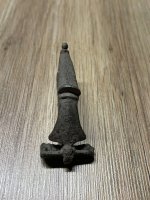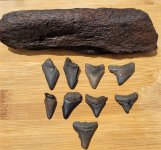funkman
Bronze Member
I am trying out this method for the first time and have a couple of questions. I am using a power adapter that is output of 9vac and 800mah. I am trying to get the rust off of a buckle (horse rein buckle). Now I know you have to put the positive wire to the relic and the negative to a spoon. I did not know which one was which and I remember someone saying that the one that bubbles would be the one. Well no matter which one I hook to the relic, I get fizzing action. Not really bubbling, just fizzing. Could be because of low amperage I know, but why is it that both leads give me fizzing? Also could I not have enough baking soda and salt in mixture. I am using a tupperware container and only have maybe a cup or 2 of water in it. Sprinkled baking soda and some salt and let it cook for a half hour with each lead. WHen I took the relic out after each half hour, I thought some rust would be coming off, but nothing is really. Do I have to still sand or file it off or should it just scrape/fall off automatically? Maybe with the low voltage I am using I need to let it cook a long time. The power supply did not get hot at all when I touched it so maybe I can safely let it cook all day.
Let me know please.
Funkman
Let me know please.
Funkman


 DC output GOOD.
DC output GOOD. 



